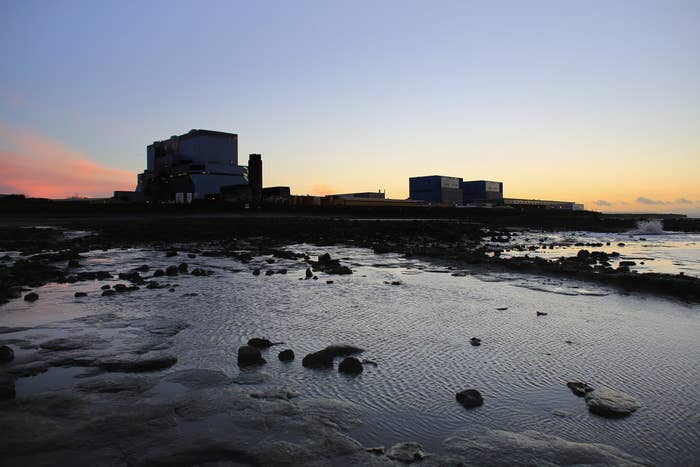
The public are deeply wary of nuclear power.
The news that the Chinese government will pay to build a nuclear power station at Hinkley Point, Somerset, has met with scepticism.
A poll commissioned by Greenpeace has found that only 29% of the public support the move, compared with 34% who oppose it.
That's roughly in line with opinion polls on nuclear energy in general. An Ipsos MORI poll for the UK Energy Research Council found that nuclear was one of the least popular forms of energy production, down with coal and oil: Only 34% of the public have a favourable opinion of it.
That's partly because the public think that nuclear power is dangerous: A Eurobarometer poll for the OECD found that 55% of Europeans think that the risks of nuclear power outweigh the potential benefits.

But the risks are usually overblown. Other than at Chernobyl, no one has died in a nuclear accident.
In 1986, a badly designed reactor near the Ukrainian town of Chernobyl – then part of the Soviet Union – exploded, releasing large amounts of radioactive material into the atmosphere.
Forty-seven people have so far died as a direct result of the radiation – almost all of them emergency workers who were exposed on the day of the disaster. The World Health Organisation estimates that that figure could rise as high as 4,000, as people develop cancers later in life. The United Nations Scientific Committee on the Effects of Atomic Radiation attributes 6,000 cases of thyroid cancer in eastern Europe to the accident. That's a large number, but tiny compared to the size of the population of the region.
There have been other accidents, of varying severity, but none of them have caused any deaths. Most famously, in 2011, a gigantic earthquake in Japan badly damaged a power station in Fukushima prefecture. But while the earthquake and resulting tsunami killed around 15,000 people, there were no deaths from radiation, and at the time of writing only one case of cancer has been linked to the plant. Similarly, the accident at Three Mile Island in Pennsylvania in 1979, although it required a huge clean-up, caused no deaths and no detectable increase in cancer rates.
Living near a plant probably doesn't cause cancer.
In 1983, a television documentary pointed out that there were a large number of childhood leukaemia cases near Windscale, a British nuclear power station (now known as Sellafield). It led to an inquiry, which failed find any link between the power station and the cases of leukaemia, but recommended a body be formed – the Committee on Medical Aspects of Radiation in the Environment – which would make regular reports on the risk. The most recent report, published in 2011, found that "there is no evidence to support the view that there is an increased risk of childhood leukaemia and other cancers in the vicinity of NPPs [nuclear power plants] in Great Britain".
Another study, of 20,000 British children, similarly found no link. One study in Germany did find an increased risk of leukaemia for children living within 5km of a plant. Because childhood cancer is extremely rare, it is very difficult to establish a statistical link.

High-level nuclear waste needs to be buried somewhere safe for about 10,000 years.
According to the OECD, the world produces about 400,000 tonnes of radioactive waste a year. That's about 0.1% of the amount of hazardous waste produced in general – things like toxic chemicals and carcinogens.
About 2% of that nuclear waste is "high-level" waste (HLW), which will remain radioactive for thousands of years. Although it only makes up a small proportion of the total mass of waste, it accounts for 97% of the radiation. HLW in the UK is stored in water-cooled silos behind thick concrete walls. However, the OECD believes that at some stage it will all have to be buried hundreds of metres underground: It says there is a global consensus that this is the best way to dispose of it.
Using the OECD's data, this blog estimates that most HLW will have decayed to the same level of radioactivity as naturally occurring uranium ore within about 10,000 years. That's a long time, but HLW is usually made into a solid, rock-like substance, and if stored somewhere geologically stable, can be expected to remain there for about a billion years. This University of Pennsylvania professor estimates that the increased radiation caused by deeply buried nuclear waste would probably cause about one extra death per nuclear power station over several million years.

Despite its risks, nuclear is much safer than many other forms of energy generation.
NASA's climate and energy division estimates that the shift away from coal to nuclear power "prevented an average of over 1.8 million net deaths worldwide between 1971-2009", by reducing the number of deaths caused by air pollution. Other fossil fuels are cleaner, but NASA says that even the cleanest natural gas is still 40 times as deadly as nuclear energy per unit of electricity produced.
The International Energy Agency estimates that, worldwide, coal energy causes about 100 deaths per terawatt-hour of energy produced. Natural gas causes about 4, wind 0.15, and nuclear just 0.04.
The climate impact of nuclear power is very low.
The International Atomic Energy Agency says that nuclear energy's carbon footprint is "comparable to hydro power", and far less than any fossil fuel. NASA agrees: "We calculated that nuclear power prevented an average of 64 gigatonnes of CO2-equivalent (GtCO2-eq) net GHG [greenhouse gas] emissions globally between 1971-2009 ... This is about 15 times more emissions than it caused."
